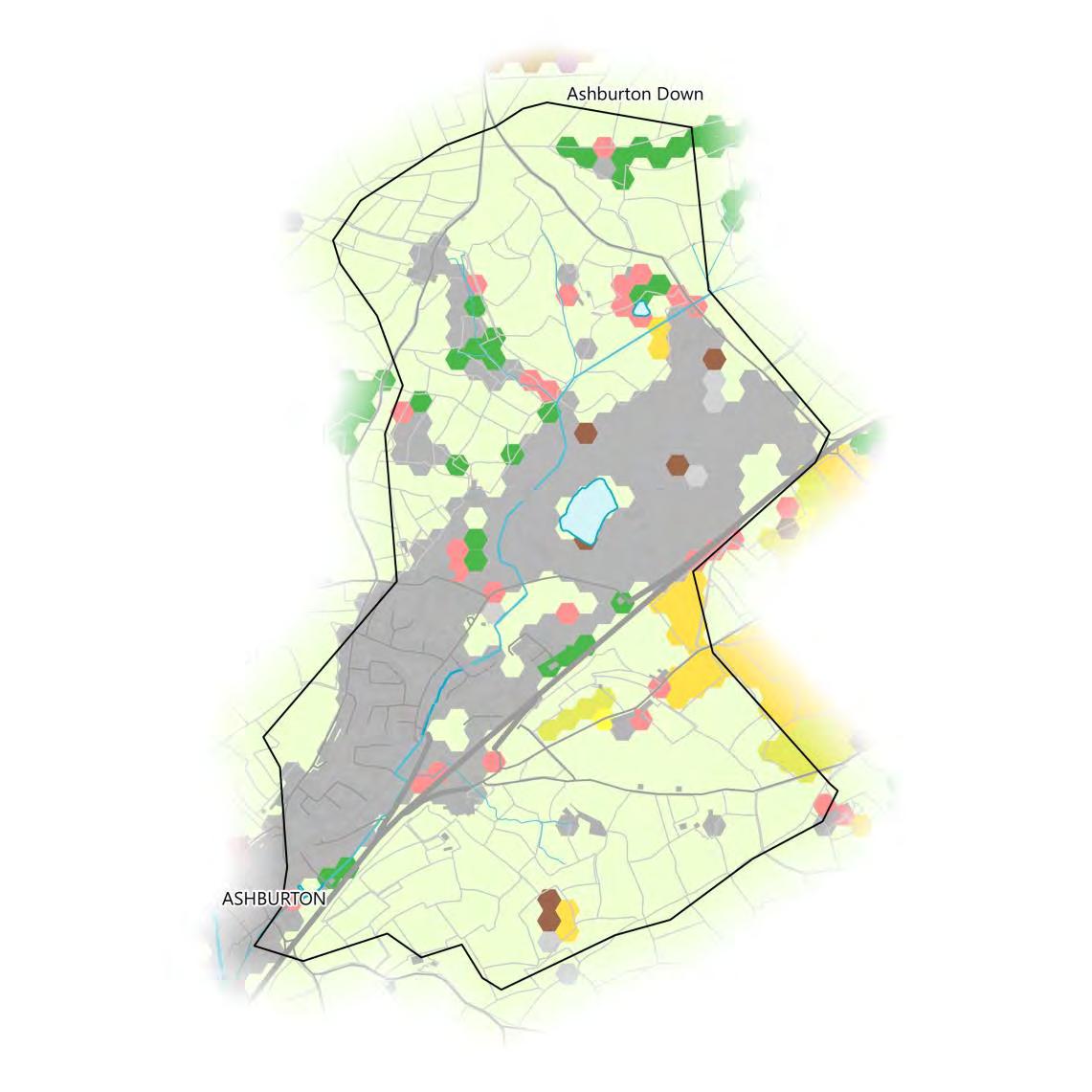
27 minute read
Existing Natural Assets and their Condition
Crops
Crops can be a natural asset in themselves, providing the food we eat and storing carbon. Some crops however, could be considered natural liabilities. One such crop is maize which is planted in wide rows, leaving bare soil exposed and without structural support from roots. Furthermore, it is often harvested in late-Autumn when the weather becomes wetter, meaning little to no vegetation can regrow to protect it over Winter. This leaves the soil much more susceptible to being carried away by surface water runoff. Despite this, maize can be successfully managed to grow and harvest while minimising runoff. The Crop Map of England (CROME) dataset is derived from satellite data and generalised to hexagons. It identifies the town of Ashburton and the quarry as non-vegetated with the majority of the catchment classed as grassland, and various scattered clusters of trees. Some maize is grown in the southeast below the A38.
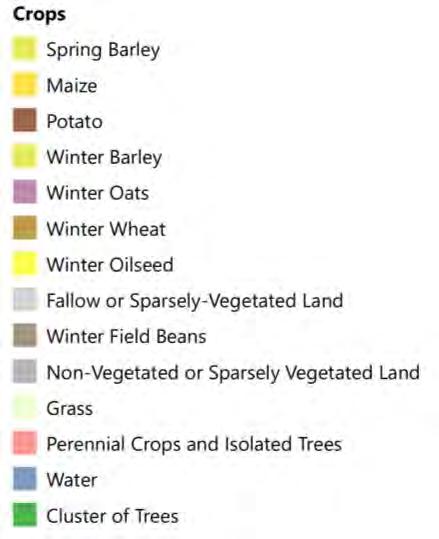
Existing Natural Assets and their Condition
Soils
The nature of the soil can determine how much surface water infiltrates into the ground, as well as what plants will grow and where. Understanding soils is vital to providing effective NFM and improving water quality. The aim with water quality improvements is to keep the soil on the land and improve groundwater infiltration and recharge, therefore allowing a slower and more naturally filtered water route to the river. Degraded soil structure, where the soil profile is compacted at shallow depths or capped at the surface and impermeable can lead to excessive unnatural run-off of surface water instead of percolation and infiltration. More than 60% of soils in Devon and Cornwall are naturally well-drained and should rarely become saturated. The Farming Rules for Water (FRFW) were introduced at the start of 2018 as legislation to help protect surface water quality. The regulations are designed to help manage cultivated agricultural land well, without over-management, nutrient run-off, or waste affecting surface water.
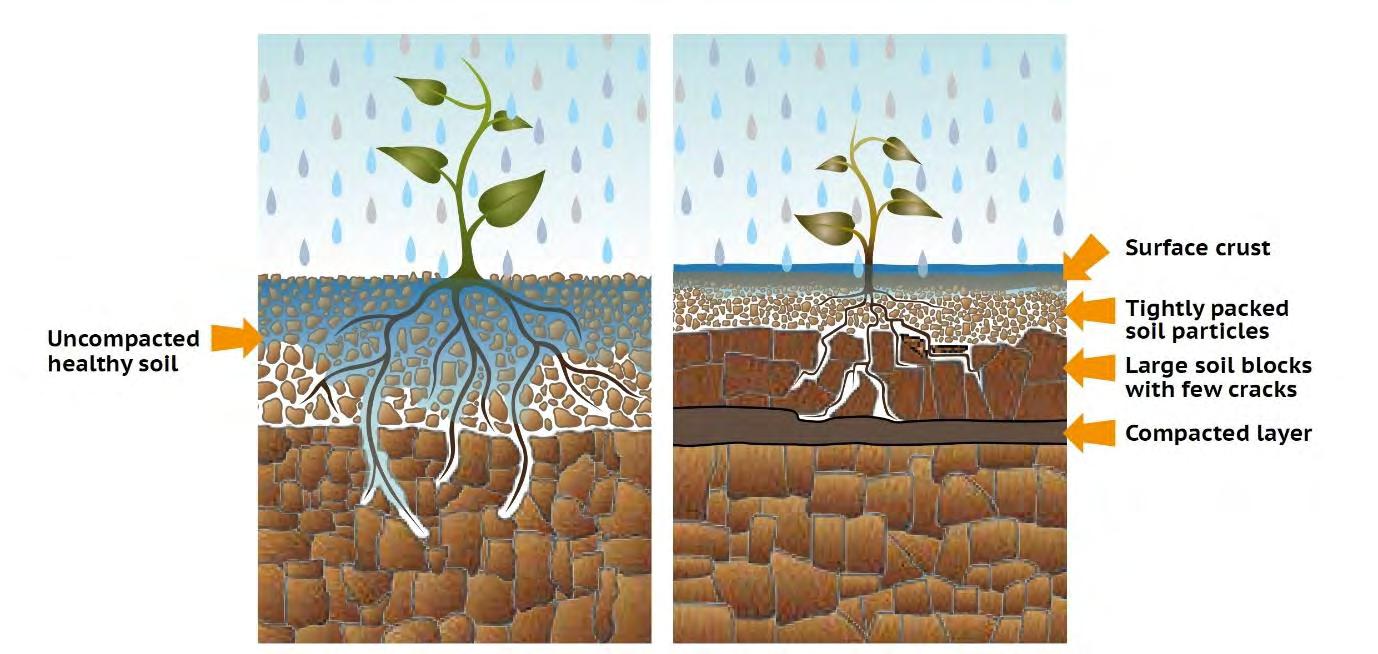
The diagram above shows good soil structure on the left and compacted soil structure on the right. In compacted soil, little surface water can infiltrate into the soil subsoil due to surface capping or compacted layers, while vegetation can be deprived of oxygen due to compression of pores that normally transport air and water (sourced from SEPA NFM Handbook).
Existing Natural Assets and their Condition
Soils
The NATMAP soils dataset from Cranfield University shows that the catchment is primarily composed of the soil series Denbigh 1, followed by Nordrach around the quarry area and either side of the A38, and a small area of Manod to the west.
At the time of survey, soil health in the catchment was considered adequate through general observation and further investigation may be needed to conclusively determine. Possible compaction of pastures would need confirmation through VESS surveys. The fields in the Nordrach series were more likely to be used for arable crops, although here too were several horse paddocks.


The above map was created using the NATMAPvector dataset from Cranfield University in March 2022
Existing Natural Assets and their Condition
Geology
Geological conditions impacts groundwater and soil type. When rocks are sufficiently permeable it can lead to groundwater flooding. If local flooding is caused be groundwater levels then it is unlikely that changes to land management and NFM will improve flood resilience. According to the British Geological Survey, Ashburton, the quarry, and the A38 have underlying limestone. The south of the catchment is primarily siltstone and basalt with some occasional pyroclastic rocks, and separated from the limestone in the catchment centre by a band of tuff. A similar band of argillite separates the north of the catchment from the limestone, and is followed by sandstone, mudstone, and chert.

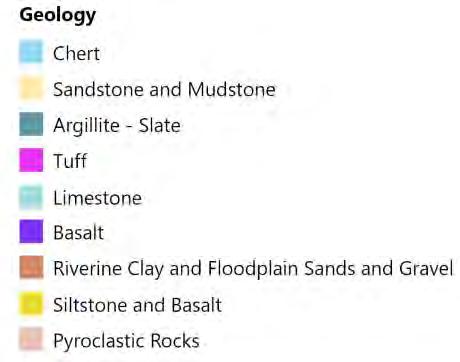
Issues
Multiple issues have already been mentioned and mapped that could be contributing to flood risk and WFD failures. However, there are further potential issues that may be influential which will be explored in the following pages.
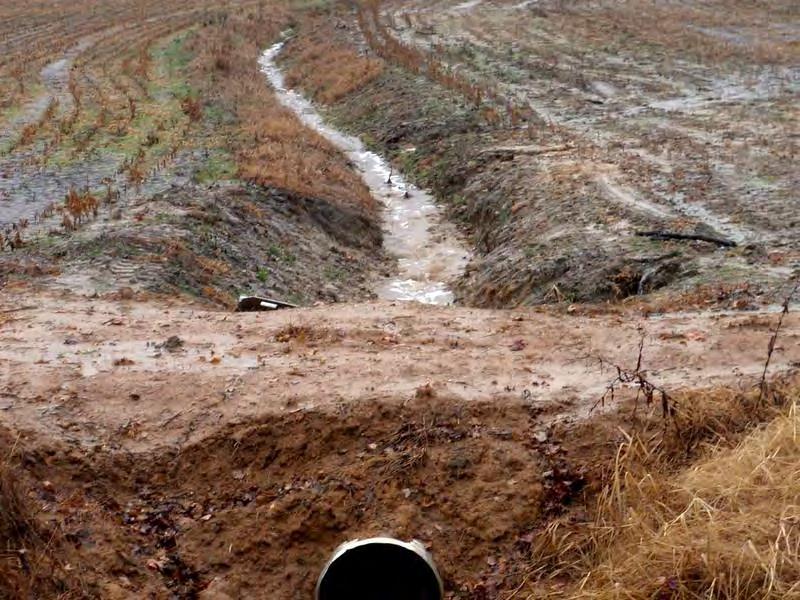
Issues
Pollution and Abstraction
Pollution incidences themselves will directly affect water quality, but consented discharges into watercourses and chemical runoff from roads exacerbated by rainwater may also be sources of pollution. Two sources of consented discharges are present in the catchment, one for trade discharging treated effluent into the Balland Stream. The other is for treated effluent from a business park into a soakaway.
There are no recorded pollution incidences in the catchment but a southwestern section of the A38 is a road prioritised for catchment management of runoff. This means the road itself may benefit from reduced runoff further up in the catchment. Just outside of the catchment, the eastern end of the A38 is a priority road for catchment management of surface water quality, meaning the highway drainage system discharges into a catchment where it could be affecting river water quality. Licensed water abstraction points may serve as sources of risk to ground water quantity and availability. However, there are no water abstraction points present in this catchment.
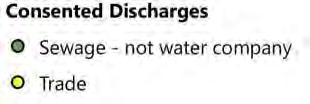
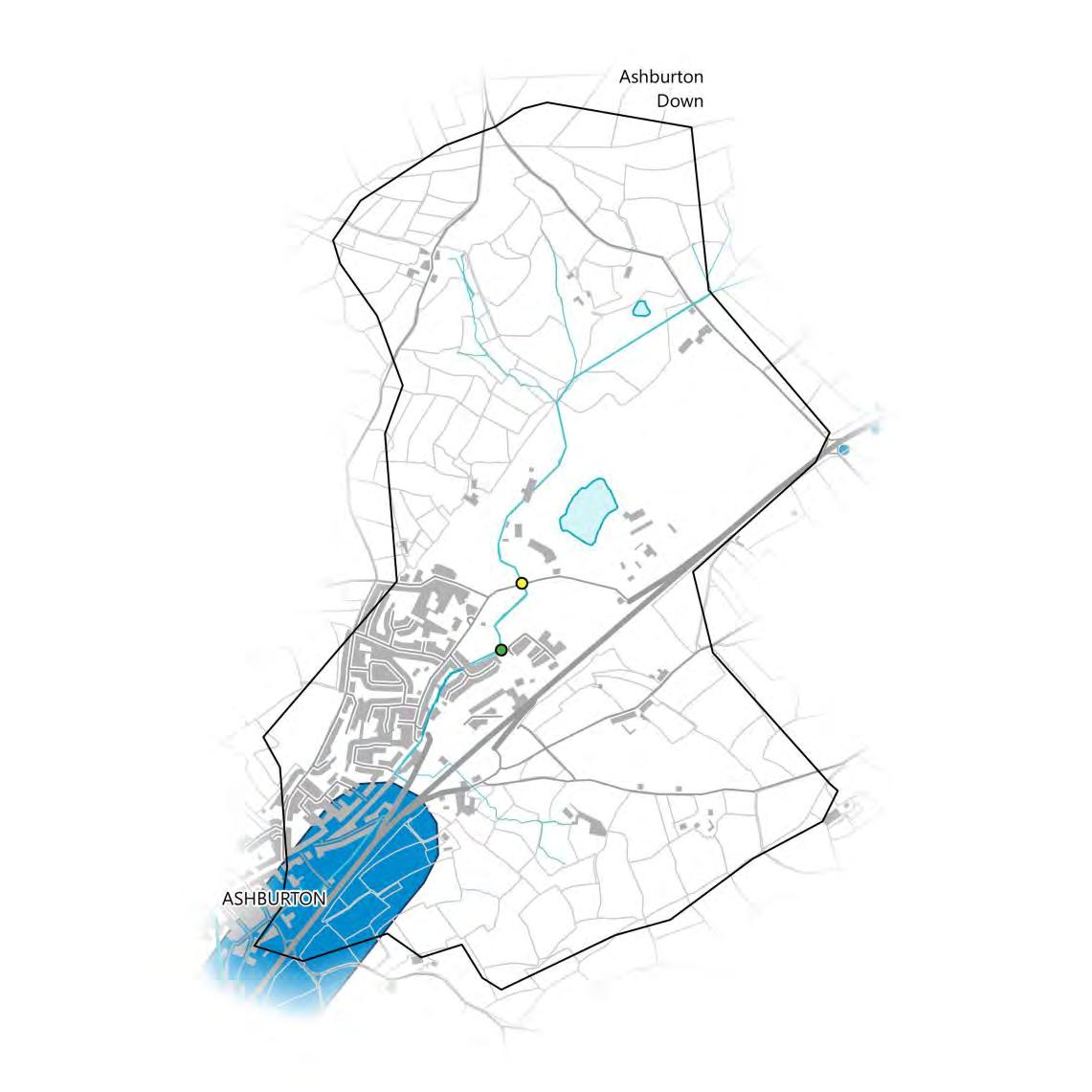
Issues
Hydrological Connectivity
Surface flow pathways are the routes rainwater accumulates and follows when it lands to the nearest depression or watercourse. As it flows, surface water can pick up any number of chemicals, soil, and debris and carry them into the watercourse with it. This serves to demonstrate why community engagement and working with land owners is so important, as the effects of practices upstream in the catchment cascade down via these routes. Pathways have been modelled in 2 different ways here. The first are modelled using topographic data and software called SCIMAP (left). Only the routes with above average wetness are shown. The flat topography of floodplains and the unnatural topography of the quarry skews the modelling process and the pathways in these areas should be considered unreliable. The second method uses SCALGO Live (right). Flow routes with at least 1km2 upstream area are shown. Areas that would be flooded if 15cm of rain were to fall during a storm event are also mapped. Flooded areas are coloured by their water volume from light to dark.
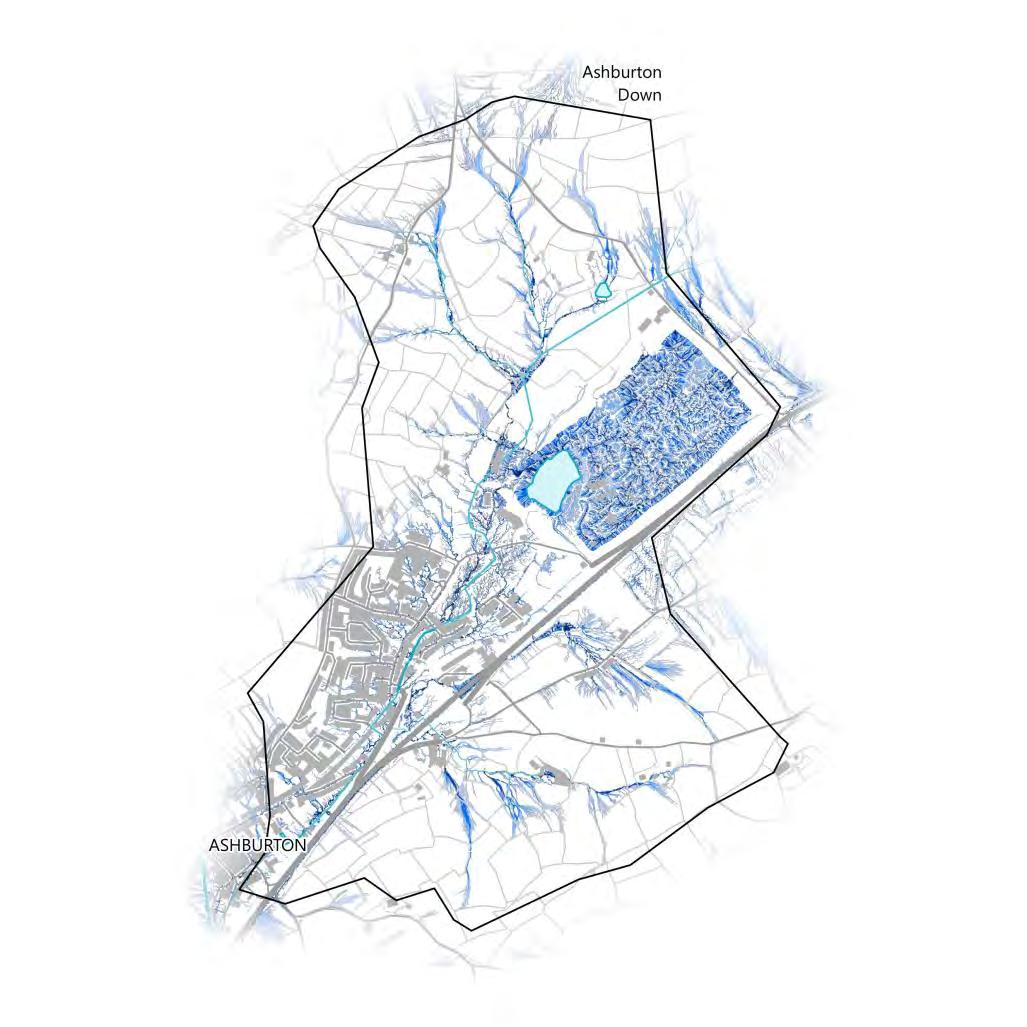

Issues
Issues Identified During Walkover Surveys
During the walkover surveys, experienced surveyors at WRT recorded points of interest and concern, as well as potential natural flood management opportunities. The results are mapped (right) but it should be noted that the map is by no means exhaustive.


Left: Narrow steep lanes with banked hedges channel runoff rapidly downhill.
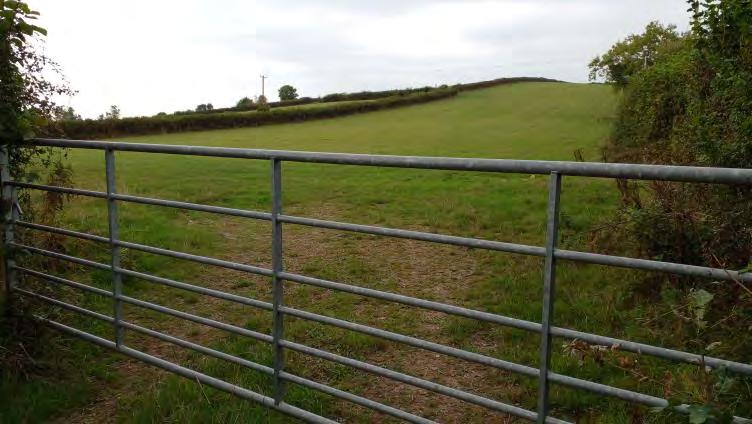
Left: Steep fields with little vegetative 'roughness' allow run off to pass uninterrupted through open gateways onto lane pathways.
This map of issues was generated after one walkover survey, reflecting the situation at the time of survey. It is not exhaustive and doesn’t reflect all issues present in the catchment which will take much more effort to determine. A greater range of all the issues is present within the previous section. Any projects delivering in the catchment should undertake their own walkovers for confirmation and addition to the list
Opportunities
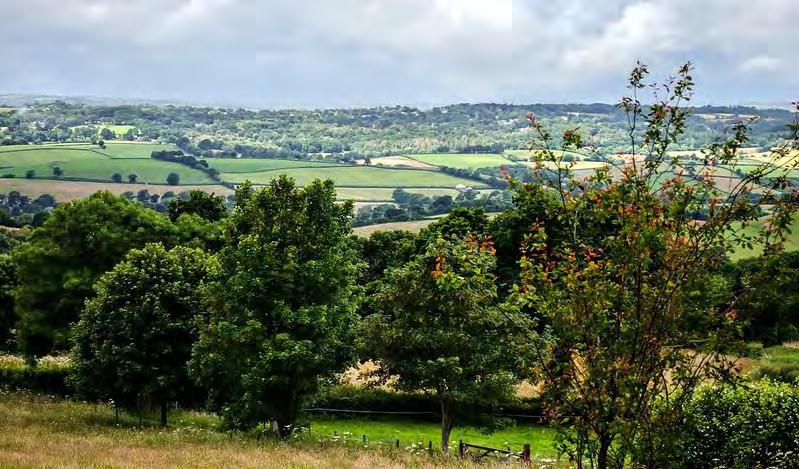
Oppor tunities
Working With Natural Processes
There are many options to reduce flood and coastal erosion risk across the country which involve implementing measures that help to protect, restore and emulate the natural functions. These options are known as Working With Natural Processes (WWNP) or Natural Flood Management (NFM). These measures increase flood resilience by slowing the flow of water and disperse energy to keep the water at the top of the catchment or to improve groundwater infiltration and recharge, therefore allowing a slower and more naturally filtered water route to the river. Where rapid surface water run-off has been noted there may be opportunities for WWNP to mitigate both water quality and to regulate flow. An example of some NFM interventions are given below. They are intended to slow water, store water, increase infiltration and intercept rainfall.
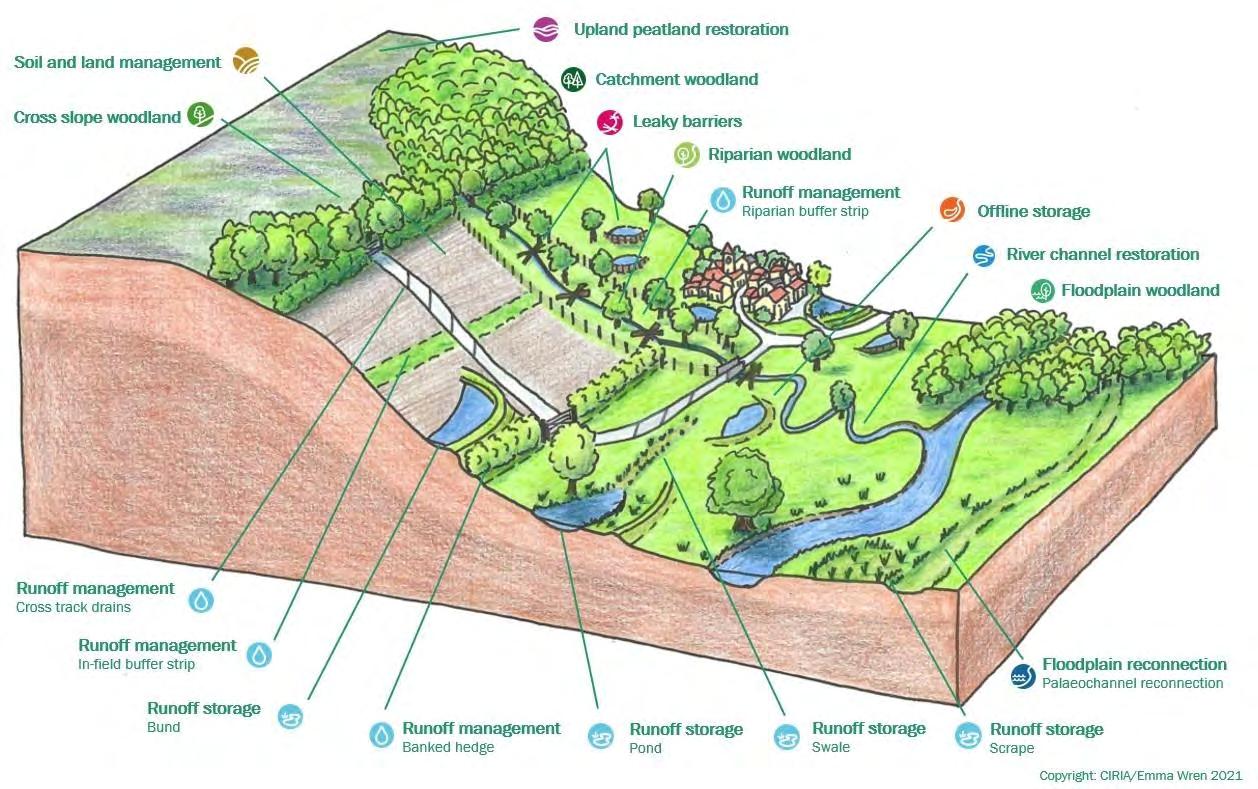
The illustration above shows various natural flood management techniques (sourced from CIRIA).
Oppor tunities
Working With Natural Processes
The Environment Agency have mapped potential opportunities for WWNP to reduce flood and coastal erosion risk across the country. These include opportunities for different types of woodland planting, floodplain reconnection features like restored riverside wetlands and meadows, and runoff attenuation features which aim to slow pathways of water across the land, like storage ponds or leaky barriers. A number of areas are also excluded from the woodland maps such as urban areas and existing woodland. These are mapped separately on page 40. The greatest opportunity identified by these WWNP datasets for the catchment is riparian tree planting along the small streams further up the catchment before they converge to form the Balland Stream. In addition, there are opportunities to construct smaller scale runoff attenuation features near the streams and the main roads that are strategically placed to slow the flow of surface water before it reaches the water course, allowing excess water to dissipate rather than flood during a storm event.
Furthermore, it may be possible to reconnect some small areas of floodplains downstream in the catchment adjacent to the A38 that work in tandem with the runoff attenuation features.
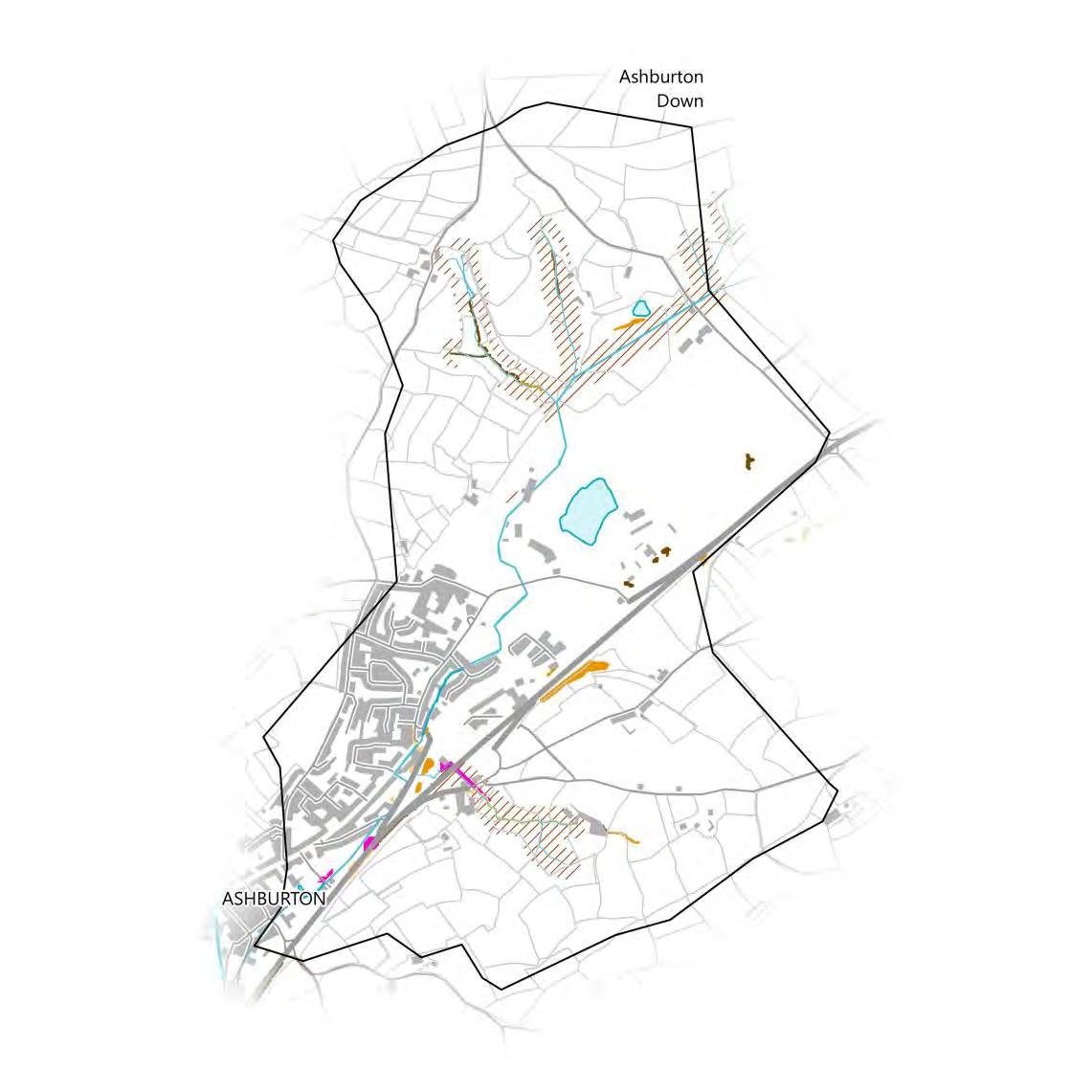
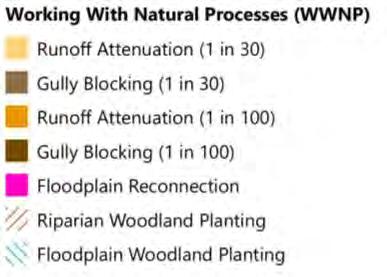
Oppor tunities
Habitat Creation and River Restoration Projects
There may be current habitat creation and river restoration projects where opportunities exist to work together with organisations to provide simultaneous benefits to habitats, rivers, and flood resilience.
Natural England have also identified opportunities to expand on existing habitats to create habitat networks across the landscape. While there are no recorded habitat creation or river restoration projects in the catchment, there are significant opportunities for expanding habitat networks around existing priority habitats (see page 24). There are Fragmentation Action Zones around the lowland meadows. Natural England defines these as “Land immediately adjoining existing habitat patches that are small or have excessive edge to area ratio where habitat creation is likely to help reduce the effects of habitat fragmentation.” Just outside this and below the A38 surrounding the traditional orchard is Network Enhancement Zone 1, defined as “Land within close proximity to the existing habitat components that are more likely to be suitable for habitat re-creation for the particular habitat. These areas are primarily based on soils but in many cases has been refined by also using other data such as hydrology, altitude and proximity to the coast.” Elsewhere in the catchment is the Network Expansion Zone, defined as “Land within relatively close proximity to the Network Enhancement Zones that are more likely to be suitable for habitat creation for the particular habitat and identifying possible locations for connecting and linking up networks across a landscape.” Much of the urban area is classed as Network Enhancement Zone 2, “Land within close proximity to the existing habitat components that are unlikely to be suitable for habitat re-creation but where other types of habitat may be created or land management may be enhanced including delivery of suitable Green Infrastructure.”
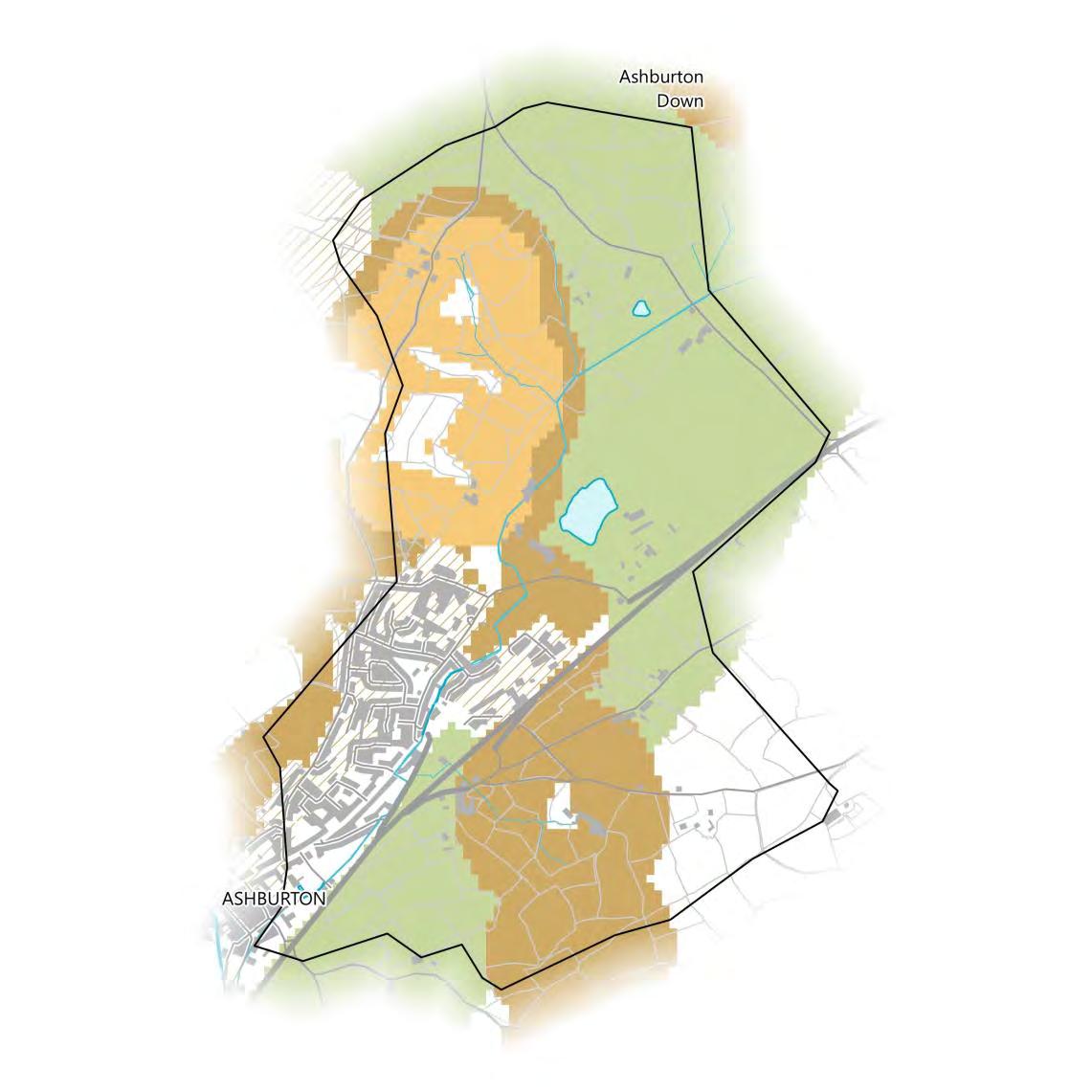
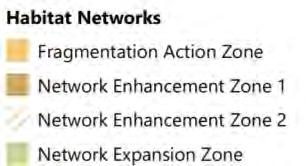
Oppor tunities
Agri-environment Schemes
Agri-environment schemes are government initiatives that aim to financially compensate farmers for providing benefits to wildlife on their land. Areas under agri-environment scheme agreements may provide opportunities simultaneously for the landowner to meet the agreement’s objectives and deliver NFM to benefit the catchment community. The majority of the land parcels in the northern area of the catchment are under Organic Farming Scheme Agreements, while a handful of land parcels south of the A38 are under Environmental Stewardship Agreements. There may be opportunities for landowners in the northwest and south of the catchment to enter into agri-environment schemes. Habitat creation in the south in particular may be facilitated in the Habitat Enhancement and Expansion Zones as identified on page 38 if landowners were to enter into an agri-environment scheme.
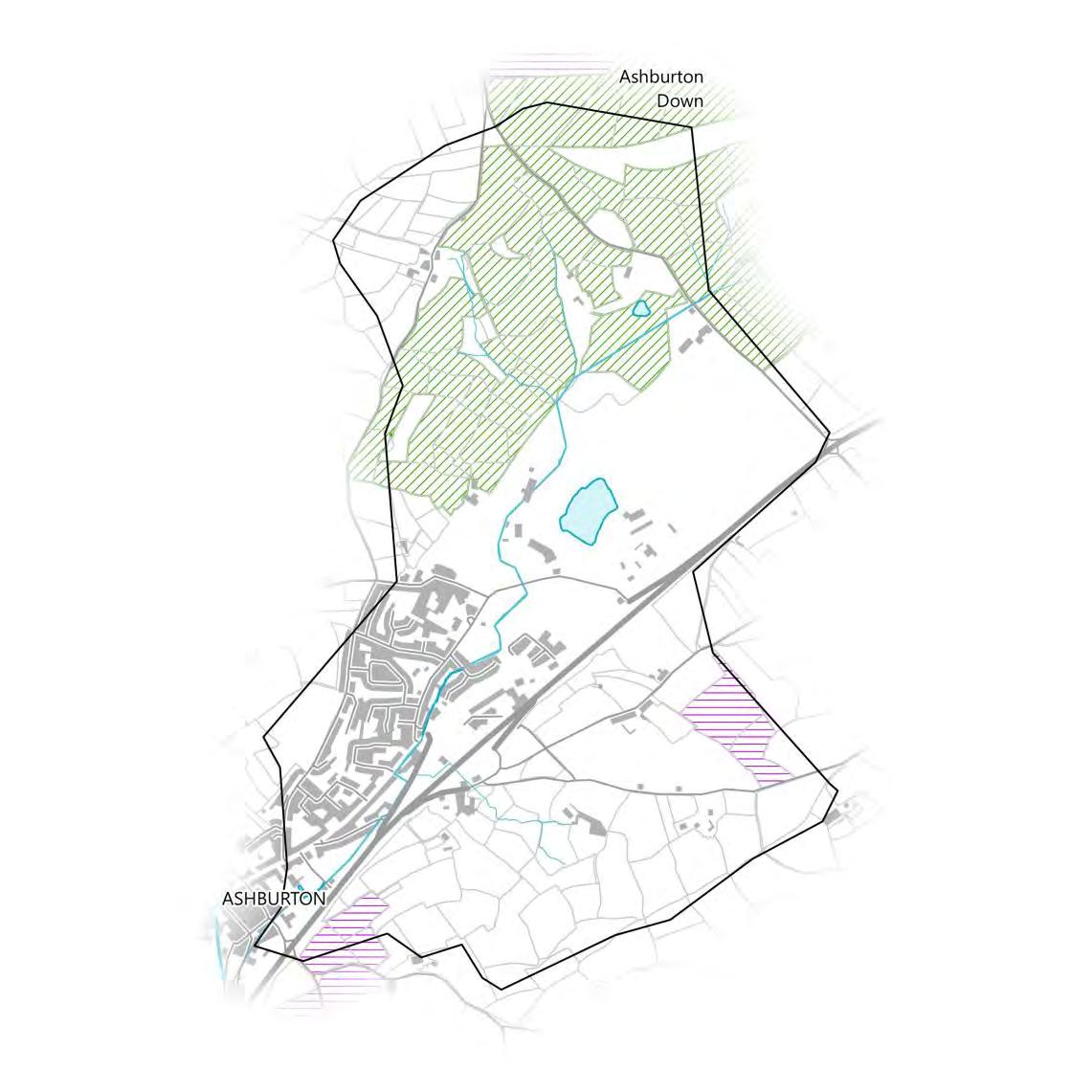

Oppor tunities
Restrictive Areas
A further consideration for the targeting of NFM via soil improvement, habitat enhancements, restoration or creation is existing areas which may not be suitable for changes in land use or land management. This may be because they are already valuable sites for wildlife (e.g. designated wildlife sites), because the land use is difficult to change (e.g. urban land) or because the land is highly valuable for farming (high grade agricultural land). There may be further historic or natural heritage designations to consider.
The Dartmoor National Park designation (see page 20) north of the A38 in the catchment may provide administrative challenges, as will the woodland, lowland meadows, and traditional orchard priority habitats. However, there is still the opportunity to improve these habitats and designated sites further by getting more partner organisations involved in the process and even access additional sources of funding.
The WWNP woodland constraints dataset highlights any urban areas and existing woodlands (including woodlands not listed as priority habitats not shown here) where additional tree planting may be difficult. This excludes much of the urban centre of the catchment and the quarry. This does not mean urban tree planting is impossible, and would also provide another avenue to get the community involved the closer the planting is. The northwest and southern areas of the catchment on the other hand have few to no restraints.
The agricultural land grade is grade 3 across the catchment which is considered average and there is therefore no high grade land present. There are also no scheduled monuments present.

Oppor tunities
Opportunities Identified During Walkover Surveys
During the walkover surveys, experienced surveyors at WRT identified opportunities for NFM measures and improvements to other key considerations mentioned. The results are mapped (right) but it should be noted that the map is by no means exhaustive.

Area north of quarry where tributaries of Balland stream join. Existing sediment ditch captures run off from spoil bund pictured. Opportunity to naturalise and enhance area next to PRoW, subject to quarry expansion works. A greater range of all the opportunities is present within the following section. Engagement with landowners and stakeholders is required for a more comprehensive list of opportunities and ascertain if suggestions can be implemented in conjunction with current land use, future land use and business plans.
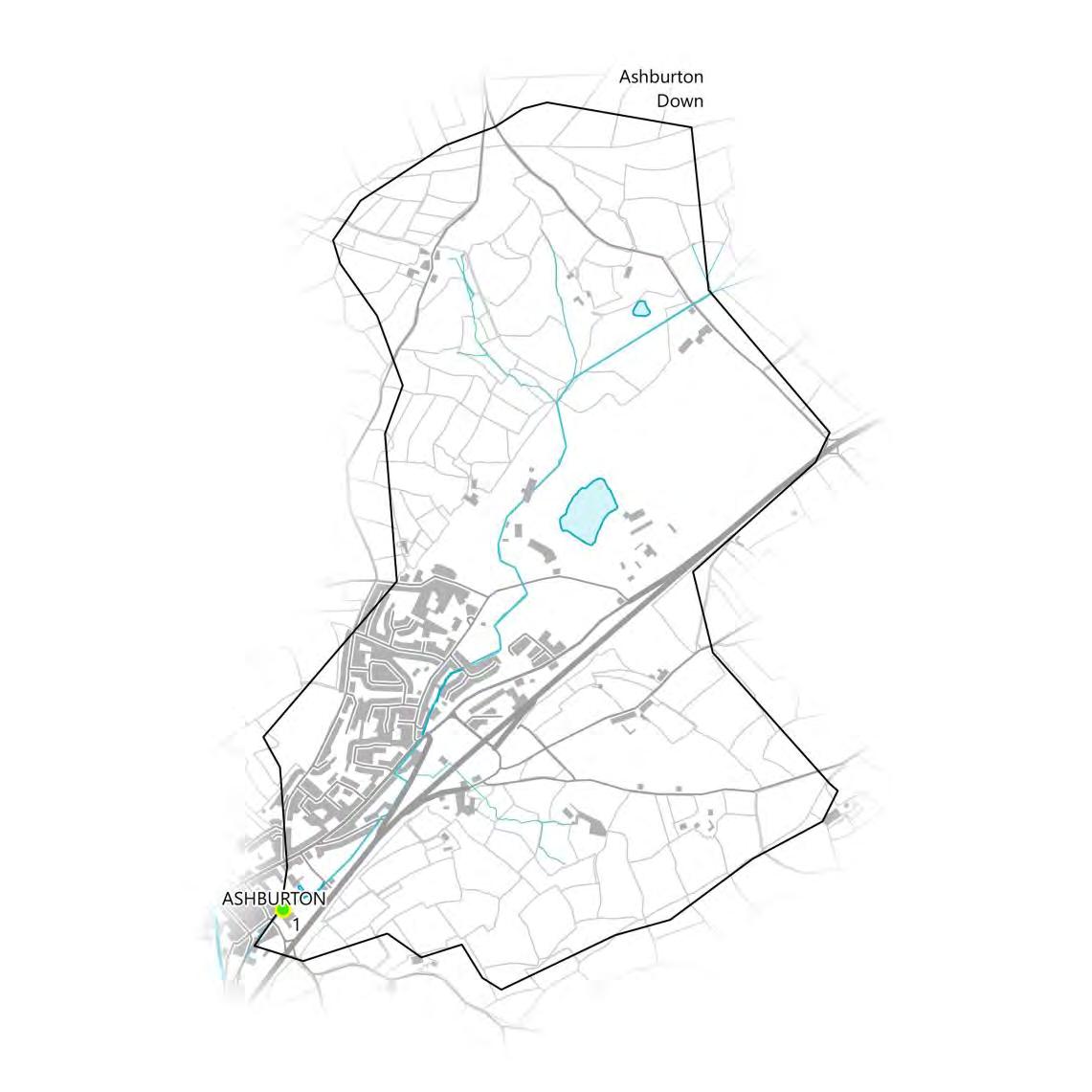
Oppor tunities
There are some opportunities to improve flood resilience, especially in the upper catchment through changes to soil management.
Improve soil health and rainfall acceptance potential
Potential benefit in catchment
Sub-soil, aeration, or decompaction ✓
Contour ploughing or cross slope working
Change land use
Interspersed woodland or agroforestry for infiltration
Peatland/wetland/culm restoration
Potential provider identified
Location of opportunity matches GIS maps
Na
Oppor tunities
There are some opportunities to improve flood resilience in the Balland Stream through water pathway interruption.
Cross-slope planting of trees or hedges
Gateway relocation
Cross-slope buffer (beetle bank or cross-drain)
Potential benefit in catchment
Timber/stone instream deflectors ✓
Potential provider identified
Location of opportunity matches GIS maps
Oppor tunities
There are some opportunities to improve flood resilience in the Balland Stream through water attenuation on nonfloodplain wetland.
Attenuation pond / farm pond / wildlife pond
Run-off scrape or swale / temporary pond
Run-off bunded storage or off-line storage
Blind ditching in drainage ditches
Headwater drainage management ✓
Potential benefit in catchment
Attenuation pond / farm pond / wildlife pond
Potential provider identified
Location of opportunity matches GIS maps
Oppor tunities
There are some opportunities to improve flood resilience in the Balland Stream through increasing channel and floodplain roughness to slow the flow.
Channel restoration, sinuosity
Large/coarse wooded debris introduction
Riparian buffer strips or woodland (sloped)
Floodplain woodland or wet woodland
Peak flow leaky barriers
Bed renaturalisation– armour/ gravel augmentation
Potential benefit in catchment Potential provider identified Location of opportunity matches GIS maps
Engagement

Engagement
Current Engagement
There are 21 landowners in the catchment. WRT has engaged with farmers managing 14.45% of the total farm area under UST. The 3 largest landowners own 34.23% of the catchment.
The local community appears to already have measures to increase the climate resilience of Ashburton. Details of the village’s flooding group can be found on slide 17. The community response group are a local Facebook group called Ashburton Climate Emergency (ACE). This is for residents of Ashburton to communicate about local solutions to face the climate emergency. They mainly focus on the areas of Energy (creation & conservation); Food, Farming & Forestry; Transport; Caretaking (biodiversity, water & pollution); Recycling, Re-use, Repair & Making and Wellbeing & Resilience. ACE are sanctioned and supported by Ashburton Town Council. It was set up in the Spring of 2019 and expanded its activities in March 2020 to include social and mental wellbeing in the face of the COVID-19 pandemic.
Engagement
Getting Involved
As well as the opportunities identified in the previous section, there may be opportunities for you to get involved as an individual. WRT runs a Citizen Science Investigation (CSI) team of volunteers across the south west, whereby volunteers receive a testing kit and training to procure water samples from a watercourse. Westcountry CSI aims to engage people with their local environment, and produce water monitoring data that can identify pollution events quickly and target improvement work. There is an active CSI sampling site in the south of the catchment. There may be the potential for more sampling sites along the main Balland Stream in Ashburton and further up the catchment in the north if there is suitable access to the water.
For more information about Westcountry CSI, including instructions on what’s involved and how to sign up, visit our website at wrt.org.uk/westcountry-csi Another opportunity for you to get involved in is the Riverfly Partnership’s Anglers’ Riverfly Monitoring Initiative (ARMI). This recognises that anglers are very well placed to monitor river water quality and facilitates communication between them and their local Environment Agency contact. There are no riverfly survey sites within the micro-catchment, but, as with CSI sites, it may be possible to start a new site if there is suitable access to the water and with communication with the Environment Agency. For more information on ARMI, visit their website at riverflies.org/anglersriverfly-monitoring-initiative-armi

Summar y and Next Steps
Multiple reasons for the possible causes and remedies for flooding in the micro-catchment for the Balland Stream have been mapped in this study, as have other factors that are key to consider when making NFM decisions.
It is likely that a combination of causes are at play here contributing to there being properties at flood risk, including the topography, land use, lack of surface water runoff diversion from roads, and absence of habitats in certain areas of the catchment.
The next steps are to engage and empower the community in the catchment to discuss and work towards building flood resilience through some of the opportunities mapped in the previous pages. It is imperative that property owners and landowners share perspectives and work together to find solutions agreeable to all sides. Some opportunities may provide secondary benefits towards improving the catchment’s WFD chemical status.
Appendix

Methodology Details
Step 1: Micro-catchment Mapping Method
The process for identifying the highest-impacting locations of NFM measures across Devon and Cornwall involved several steps in a Geographic Information System (GIS). The first step was to identify watercourses with an upstream watershed less than 10km2 and less than 5km2 in size, then to identify properties adjacent to these watercourses that overlapped with the Environment Agency’s (EA) fluvial “Flood Zone 2” dataset. Next, pour points were placed on the watercourses in front of the furthest downstream flood risk properties. These pour points were thenused to delineate the upstream micro-catchment boundaries. A total of 1270 micro-catchments with properties potentially at risk were identified across the 2 counties. For every micro-catchment identified, its area was divided by the number of flood risk properties within it to calculate the area per property at risk for each micro-catchment. Those with the lowest area per property indicated higher potential for small-scale NFM measures to benefit the greatest number of flood risk properties. Lastly, additional factors, such as WFD classifications and previous WRT engagement with farmers, were considered alongside the area per property at flood risk to prioritise a small number of micro-catchments to target community engagement and NFM delivery.
Modelling assumptions and constraints: ➢ Due to the large geographic extent (Devon and Cornwall) and the manual element of the mapping (both causing the mapping process to be time-consuming), the resolution/accuracy of some datasets may be compromised. ➢ The buildings dataset (OS VectorMap Buildings) is not as accurate as OS MasterMap - some properties are amalgamated into a single polygon and very small buildings are not shown. Therefore properties at risk of flooding may be underestimated. ➢ Potential flood-risk is identified by selecting building polygons that intersect the flood zones; no detailed local information (e.g. drainage or defences) or modelling has been used. ➢ The spatial resolution of the topography data is coarse (50m). This is used to calculate the upstream catchment area for each community at-risk.
Therefore, some errors may occur (additions or omissions) when identifying micro-catchments. ➢ The mapping method involves an element of manual validation, which has the potential to be subjective and/or possible errors.
Methodology Details
Step 2: Theoretical Ground Truthing
Once catchments were modelled and the information tabulated to show theoretical flood risk in conjunction with WFD failures, a systematic approach to ground-truthing was adopted. Catchments that were perceived to have elevated water quality and water quantity risks were discussed with local land management advisors and regulators to determine if the modelled risk was likely to be correct. Upon a theoretical, or desk-based ground-truthing, the catchments were then surveyed using a rapid walkover survey to observe run-off pathways and confirm if useful managed interventions could be implemented to reduce flood risk locally and improve water quality in the process.
Step 3: Rapid Walkover Survey
A further modelling process using SCIMAP was undertaken to identify high risk run-off pathways of the specific micro-catchment being surveyed to assist the surveyor in locating issues within a <10km2 area. Where possible, surveyors reacted to high rainfall predictions and went out to observe the catchment when the conditions were right. Walkover surveys were undertaken noting observations about surface water run-off and taking photographs of key areas and issues. All walkovers aimed to provide:
➢ Dry or Wet weather photos, ➢ Identify stakeholder PROVIDERS where NFM can be instigated, ➢ Identify stakeholder BENEFICIARIES by property and number people, ➢ Establish opportunities in each catchment and feasibility of action.
Georeferenced photos were taken to provide a visual overview of issues, opportunities, and as general reference notes. Where issues and opportunities existed, further investigation was made or attempted to establish the realistic chances of further action. This was achieved by either speaking with the local community or contacting community groups or key landowners. All 1270 micro-catchments with properties potentially at risk were identified across the 2 counties.
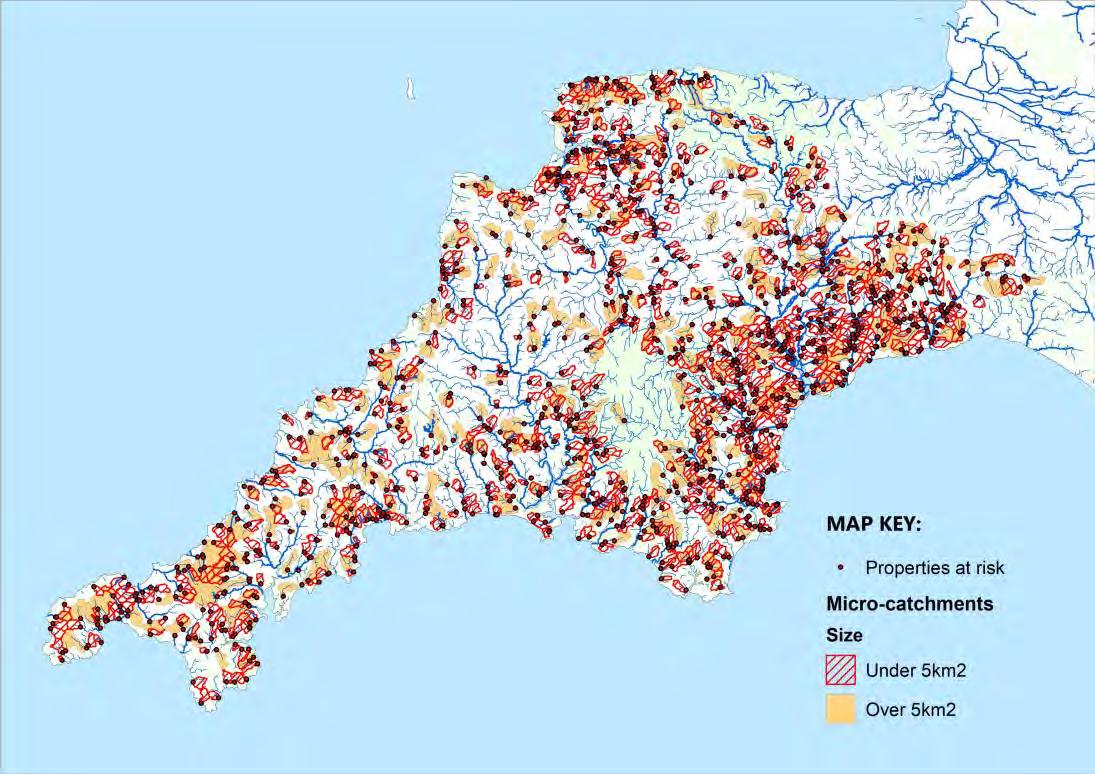
References and fur ther information
Reference
CIRIA (Slide 43)
FRFW (Slide 32)
SEPA NFM Handbook (Slide 32) Handbook describing various natural flood management interventions and case studies (PDF)
https://www.sepa.org.uk/media/163560/sepa-natural-floodmanagement-handbook1.pdf
Resource description Link
The Construction Industry Research and Information Association’s (CIRIA) Natural Flood Management Manual (C802) (PDF)
https://www.ciria.org /Books/Free_publications/C802F.aspx
Statutory guidance for Farming Rules for Water (FRFW) (Webpages) https://www.gov.uk/government/publications/applying-thefarming-rules-for-water/applying-the-farming-rules-for-water
Mapping Data Sources
Dataset Source Attribution Statement
Agricultural Land Classification Natural England © Natural England copyright. Contains Ordnance Survey data © Crown copyright and database right 2022.
Air Quality Management Areas UKAIR
© Crown copyright and database rights licensed under Defra's Public Sector Mapping Agreement with Ordnance Survey (licence No. 100022861) and the Land and Property Services Department (Northern Ireland) MOU206.
Ancient Woodland Natural England © Natural England copyright. Contains Ordnance Survey data © Crown copyright and database right 2022.
AONB Natural England © Natural England copyright. Contains Ordnance Survey data © Crown copyright and database right 2022. Areas Benefitting from Flood Defences Environment Agency © Environment Agency copyright and/or database right 2018. All rights reserved.Some features of this map are based on digital spatial data from the Centre for Ecology & Hydrology, © NERC (CEH) © Crown copyright and database rights 2018 Ordnance Survey 100024198 Bathing Water Monitoring Locations Environment Agency © Environment Agency copyright and/or database right 2015. All rights reserved. Consented Discharges Country Parks Natural England © Natural England copyright. Contains Ordnance Survey data © Crown copyright and database right 2022. Countryside Stewardship Scheme Agreements Natural England © Natural England copyright. Contains Ordnance Survey data © Crown copyright and database right 2022. Crop Map of England Rural Payments Agency © Rural Payments Agency CRoW Access Land Natural England © Natural England copyright. Contains Ordnance Survey data © Crown copyright and database right 2022. CRoW Registered Common Land Natural England © Natural England copyright. Contains Ordnance Survey data © Crown copyright and database right 2022. Detailed River Network Environment Agency © Environment Agency Crown copyright and databse right 2022. Drinking Water Safeguard Zones (Ground Water) Environment Agency © Environment Agency and/or database rights. Derived from BGS digital data under licence from British Geological Survey copyright NERC. Drinking Water Safeguard Zones (Surface Water) Environment Agency © Environment Agency copyright and/or database right. All rights reserved. Derived from BGS digital data under licence from B Survey ©NERC. Derived from Centre of Ecology and Hydrology data ©CEH ritish Geological
Energy Crop Scheme Agreements Natural England © Natural England copyright. Contains Ordnance Survey data © Crown copyright and database right 2022.
Environmental Stewardship Scheme Agreements
Flood Defences
Flood Zone 2
Greenspaces
Habitat Networks
Hillshade Historic Landfill Sites Natural England © Natural England copyright. Contains Ordnance Survey data © Crown copyright and database right 2022.
Environment Agency © Environment Agency copyright and/or database right 2020. All rights reserved.
Environment Agency © Environment Agency copyright and/or database right 2018. All rights reserved. Some features of this map are based on digital spatial data from the Centre for Ecology & Hydrology, © NERC (CEH). © Crown copyright and database rights 2018 Ordnance Survey 100024198 Ordnance Survey Contains OS data © Crown copyright and database right 2022
Natural England © Natural England copyright. Contains Ordnance Survey data © Crown copyright and database right 2022.
Environment Agency © Environment Agency copyright and/or database right 2018. All rights reserved. Contains information © Local Authorities
Mapping Data Sources
Dataset
Land Parcels
LCM2019 25m Parcels
LNR
MCZ
Source Attribution Statement
Rural Payments Agency © Crown copyright and database rights 2020 OS
Morton, D., Marston, C. G, O’Neil, A. W., & Rowland, C. S. (2020). Land Cover Map 2019 (25m rasterised land parcels, GB) [Data set]. NERC Environmental Centre for Ecology and Hydrology Information Data Centre. https://doi.org/10.5285/F15289DA-6424-4A5E-BD92-48C4D9C830CC
Natural England © Natural England copyright. Contains Ordnance Survey data © Crown copyright and database right 2022.
Natural England © Natural England copyright. Contains Ordnance Survey data © Crown copyright and database right 2022.
National Forest Inventory
National Trails
NATMAPvector Forestry Commission
Natural England
Cranfield University
Nitrate Vulnerable Zones 2021 Combined Environment Agency
National Parks Natural England
Organic Farming Scheme Agreements Natural England
OS Open Datasets
Permitted Waste Sites
Ordnance Survey
Environment Agency
PM2.5 2020 UKAIR
Contains Forestry Commission information licensed under the Open Government Licence v3.0
© Natural England copyright. Contains Ordnance Survey data © Crown copyright and database right 2022.
Soil data © Cranfield University (NSRI) and for the Controller of HMSO 2019 © Environment Agency copyright and/or database right. Derived in part from geological mapping data provided by the British Geological Survey © NERC. Derived in part from data provided by the National Soils Research Institute © Cranfield University. Contains Ordnance Survey data © Crown copyright and database rights 2016. Derived in part from data provided by the Department for the Environment, Farming and Rural Affairs © Crown 2016 copyright Defra. Derived in part from data provided by the Centre for Ecology and Hydrology © NERC. Derived in part from data provided by UK Water Companies. © Natural England copyright. Contains Ordnance Survey data © Crown copyright and database right 2022.
© Natural England copyright. Contains Ordnance Survey data © Crown copyright and database right 2022.
Contains OS data © Crown copyright and database right 2022
© Environment Agency copyright and/or database right 2015. All rights reserved.
© UKAIR crown copyright
Pollution Incidents Environment Agency
Priority Habitat Creation and Restoration Projects Environment Agency © Environment Agency copyright and/or database right 2015. All rights reserved.
Priority Habitat Inventory Natural England
Priority Habitats (Aquatic and Wetlands) Natural England
Priority Roads for Catchment Management of Runoff Highways England
Priority Roads for Catchment Management of Surface Water Highways England
Public Rights of Way Ordnance Survey
Ramsar Natural England
Recorded Flood Outlines Environment Agency
© Natural England copyright. Contains Ordnance Survey data © Crown copyright and database right 2022.
© Natural England copyright. Contains Ordnance Survey data © Crown copyright and database right 2022.
Contains OS data © Crown copyright and database right 2022
© Natural England copyright. Contains Ordnance Survey data © Crown copyright and database right 2022.
© Environment Agency copyright and/or database right 2018. All rights reserved.
Mapping Data Sources
Dataset
RoFSW Extent 1 in 1000
RPA Land Parcels
SACs
SCALGO Live Scheduled Monuments
SCIMAP Flow Pathways
Slope
Source Protection Zones
SPAs
SSSI Units
SSSIs
Vegetation Health Index
Source Attribution Statement
Environment Agency © Environment Agency copyright and/or database right 2015. All rights reserved.
Rural Payments Agency © Crown copyright and database rights 2020 OS
Natural England © Natural England copyright. Contains Ordnance Survey data © Crown copyright and database right 2022.
Historic England © Historic England 2022. Contains Ordnance Survey data © Crown copyright and database right 2022
SCIMAP SCIMAP modelling system - SCIMAP was developed at Durham and Lancaster Universities as part of a NERC grant
TellusSW
Ferraccioli, F.; Gerard, F.; Robinson, C.; Jordan, T.; Biszczuk, M.; Ireland, L.; Beasley, M.; Vidamour, A.; Barker, A.; Arnold, R.; Dinn, M.; Fox, A.; Howard, A. (2014). LiDAR based Digital Terrain Model (DTM) data for South West England. NERC Environmental Information Data Centre. https://doi.org/10.5285/e2a742df-3772-481a-97d6-0de5133f4812 Environment Agency © Environment Agency copyright and/or database right 2016. All rights reserved.
Natural England
Natural England © Natural England copyright. Contains Ordnance Survey data © Crown copyright and database right 2022.
© Natural England copyright. Contains Ordnance Survey data © Crown copyright and database right 2022.
Natural England © Natural England copyright. Contains Ordnance Survey data © Crown copyright and database right 2022.
Centre for Ecology and Hydrology © UK Centre for Ecology & Hydrology
Water Abstraction Licenses
Water Resource Availability and Abstraction Reliability Cycle 2 Environment Agency © Environment Agency copyright and/or database right 2015. All rights reserved. WFD Monitoring Sites Environment Agency WFD River Waterbody Catchments Environment Agency © Environment Agency copyright and/or database right 2015. All rights reserved. WFD River Waterbody Status Environment Agency WIMS Locations Environment Agency Uses Environment Agency water quality data from the Water Quality Archive (Beta) WWNP Datasets Environment Agency © Environment Agency copyright and/or database right 2015. All rights reserved.



